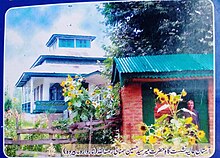Mir Syed Hussain Simnani was an Indian Sufi saint from the 8th century Hijri, known for his role in the spread of Islam in the Kashmir Valley. He hailed from Simnan in Iran and is celebrated for his philanthropic mission and spiritual teachings in South Kashmir's Kulgam district.[1] He is a descendant of the Muhammad through his grandson Imam Hussain, being the 16th in direct descent from Ali.[2] He was the cousin of the Sufi saint Mir Syed Ali Hamdani and the younger brother of Syed Tajuddin Hamdani.[3][4][5]
Mir Syed Hussain Simnani | |
|---|---|
 | |
| Personal | |
| Born | Simnan, Iran |
| Religion | Islam |
| Denomination | Sunni |
| Jurisprudence | Hanafi |
| Relatives | Mir Syed Ali Hamdani (cousin brother) |
Early life and background
editHis arrival in Kashmir, along with other Sayyids during the reign of Sultan Shahab ud din, greatly influenced the region's religious landscape. He chose Kulgam as his permanent abode, where he was engaged in spreading Islam and was eventually buried at a spot on a cliff overlooking the river Veshaw.[6][7][8]
Spiritual life
editHe played a significant role in the spread of Islam in Kashmir through his missionary work and spiritual influence. Here are some key contributions he made:
- Missionary Work: He was part of a group of hundreds of missionaries who accompanied Mir Syed Ali Hamdani to propagate Islam in Kashmir. His efforts gave a considerable boost to the conversion of the people of the valley to Islam.
- Spiritual Influence: He was known for his piety, abstinence, and spiritual powers. His presence and teachings had a profound impact on the local population, leading many to embrace Islam.[9]
- Philanthropic Mission: He engaged in philanthropic activities in Kulgam, which helped in establishing a positive image of Islam and its teachings among the local communities.[10]
- Cultural Integration: He connected the global mystical culture of Islam, or Tasawwuf, with the local mystic culture of Kashmir, known as Rishism. This integration resulted in the permanence and dominance of a unique Islamic mystical culture in the region.
- Royal Influence: Sultan Shahab ud din, the ruler of Kashmir at the time, became a follower of Mir Syed Hussain Simnani, which likely facilitated the spread of Islam due to the king's endorsement.[11]
His legacy is still celebrated today, and his shrine in Kulgam remains a place of pilgrimage for many devotees.[12]
Works
editHe is attributed to the book titled "Hazrat Mir Sayid Muhammad Hussain Simnani : Qalandar-i-Sadat". This book provides insights into his life, his journey to Kashmir, his role in reforming the thoughts and actions of the Sultans of Kashmir, and his efforts in relieving locals from superstitious beliefs through his preaching and miraculous powers. It's a valuable resource for those interested in the history of Sufism and the spread of Islam in Kashmir.[13]
References
edit- ^ Kumar, Rayees Ahmad (2022-11-05). "Hazrat Mir Syed Mohammad Hussain Simnani (RA)". Daily Good Morning Kashmir. Retrieved 2024-05-06.
- ^ "History | District Kulgam, Government of Jammu and Kashmir,Picturesque place nestling on the bank of river Veshaw | India". Retrieved 2024-05-06.
- ^ Gauhar, G. N. (1988). Sheikh Noor-ud-din Wali (Nund Rishi). Sahitya Akademi.
- ^ Fazili, Ashraf (2023-09-17). OUR HERITAGE: Kashmir Chronicles Part 2. Ashraf Fazili.
- ^ Wani, Mohammad Afzal (1996). The Islamic Institution of Mahr: A Study of Its Philosophy, Working & Related Legislations in the Contemporary World. Upright Study Home.
- ^ Kashmir Today. Directorate of Information, Jammu and Kashmir Government. 1995.
- ^ Nund-Rishi (2003). The Ark: Transcreation of Sheikh Noor-u-Din Wali. Rabani Book Stall.
- ^ SERVICE, GK NEWS (2024-02-05). "Shab-e-Meraj arrangements reviewed at shrine of Mir Syed Ali Hussain Simnani (RA) in Kulgam". Greater Kashmir. Retrieved 2024-05-06.
- ^ Rashid, Younus (2023-10-28). "Urs of Mir Syed Muhammad Hussain Simnani (RA) celebrated with fervour in Kulgam". Rising Kashmir. Retrieved 2024-05-06.
- ^ "Syed Mohammad Hussain Simnani (RA)". Kashmir Scan. 2023-01-10. Retrieved 2024-05-06.
- ^ "A spiritual guide: Hazrat Mir Syed Mohammad Hussain Simnani (RA)".
- ^ Padder, Dr Mohd Ummer Jan (2021-09-16). Status of Education. OrangeBooks Publication.
- ^ Muhammad, Zahid G. (2007). Icons of Kashmir Identity. Gulshan Books. ISBN 978-81-8339-065-1.